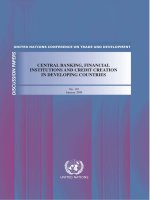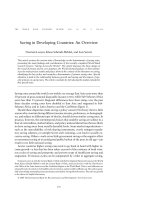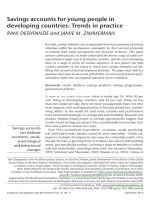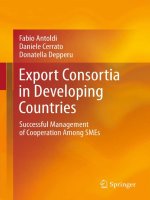Human resource management in developing countries edited by pawan s budhwar and yaw a debrah
Bạn đang xem bản rút gọn của tài liệu. Xem và tải ngay bản đầy đủ của tài liệu tại đây (1.77 MB, 285 trang )
Human Resource Management
in Developing Countries
Increasing globalisation and competitiveness have brought to the fore the
importance of effective human resource management for national and international
organisations. In recent years, there has been a remarkable development in HRM
throughout the world, however, the majority of research has focused on HRM in
advanced industrial societies. This book redresses the balance by providing a
thorough analysis of HRM in thirteen developing countries in Asia, Africa and
the Middle East.
Contributors examine the influence of core national factors on the determination
of HRM policies and practices in China, South Korea, Taiwan, India, Nepal,
Pakistan, Iran, Saudi Arabia, Algeria, Nigeria, Ghana, Kenya and South Africa.
These factors include:
•
•
•
•
national culture
national institutes
business environment
industrial sector
A common framework is used by all authors throughout the work to analyse not
only the ‘context-specific’ HRM functions in these countries, but also the diverse
and unique configurations of national factors which impact on HRM in crossnational settings.
This work will prove valuable for human resource management practitioners,
as well as scholars and students involved in teaching and researching HRM and
International Business.
Pawan S.Budhwar is Lecturer in OB and HRM at Cardiff Business School,
University of Wales. He received his PhD from Manchester Business School and
has published in the fields of international HRM, comparative management,
managerial cognition and research methods. Yaw A.Debrah is a Senior Lecturer
in Management at Cardiff Business School. He teaches courses in Human Resource
Management and Comparative Management at both undergraduate and graduate
levels. He has lived and worked in Africa, North America, Asia and Europe, and
has published numerous articles and book chapters.
Routledge Research in Employment Relations
Series editors: Rick Delbridge and Edmund Heery
Cardiff Business School
Aspects of the employment relationship are central to numerous courses at both undergraduate
and postgraduate level. Drawing from insights from industrial relations, human resource
management and industrial sociology, this series provides an alternative source of researchbased materials and texts, reviewing key developments in employment research.
Books published in this series are works of high academic merit, drawn from a wide range
of academic studies in the social sciences.
1 Social Partnership at Work
Carola M.Frege
2 Human Resource Management in the Hotel Industry
Kim Hoque
3 Redefining Public Sector Unionism
UNISON and the future of trade unions
Edited by Mike Terry
4 Employee Ownership, Participation and Governance
A study of ESOPs in the UK
Andrew Pendleton
5 Human Resource Management in Developing Countries
Edited by Pawan S.Budhwar and Yaw A.Debrah
6 Gender, Diversity and Trade Unions
Edited by Fiona Colgan and Sue Ledwith
7 Inside the Factory of the Future
Work, power and authority in microelectronics
Alan Macinlay and Phil Taylor
Also available from Routledge:
Rethinking Industrial Relations
Mobilisation, collectivism and long waves
John Kelly
Employee Relations in the Public Services
Themes and issues
Edited by Susan Corby and Geoff White
The Insecure Workforce
Edited by Edmund Heery and John Salmon
Public Service Employment Relations in Europe
Transformation, modernisation or inertia?
Edited by Stephen Bach, Lorenzo Bordogna, Giuseppe Della Rocca and David Winchester
Reward Management
A critical text
Edited by Geoff White and Janet Druker
Working for McDonald’s in Europe
The unequal struggle?
Tony Royle
Job Insecurity and Work Intensification
Edited by Brendan Burchell, David Ladipo and Frank Wilkinson
Human Resource
Management in
Developing Countries
Edited by
Pawan S.Budhwar
and Yaw A.Debrah
London and New York
First published 2001
by Routledge
11 New Fetter Lane, London EC4P 4EE
Simultaneously published in the USA and Canada
by Routledge
29 West 35th Street, New York, NY 10001
Routledge is an imprint of the Taylor & Francis Group
This edition published in the Taylor & Francis e-Library, 2003.
© 2001 Editorial selection and material, Pawan S.Budhwar and Yaw A.
Debrah; individual chapters, the authors
All rights reserved. No part of this book may be reprinted or reproduced
or utilised in any form or by any electronic, mechanical, or other means,
now known or hereafter invented, including photocopying and recording,
or in any information storage or retrieval system, without permission in
writing from the publishers.
British Library Cataloguing in Publication Data
A catalogue record for this book is available from the British Library
Library of Congress Cataloging in Publication Data
Human resource management in developing countries/edited by Pawan
S.Budhwar and Yaw A.Debrah.
p. cm.
Includes bibliographical references and index.
1. Personnel management—Developing countries. 2. Human capital—Developing
countries—Management. I. Budhwar, Pawan S. II. Debrah, Yaw A.
HF5549.2.D48 H859 2001
658.3´009172´4–dc21
ISBN 0-203-46437-0 Master e-book ISBN
ISBN 0-203-77261-X (Adobe eReader Format)
ISBN 0-415-22333-4 (Print Edition)
00–051780
To Laxmi and Gaurav, who gave me the freedom to
complete this task.
To Dorothy, Denise, Lorraine and Derek with all my love
To those who are interested in international HRM
and its progress in developing countries.
Contents
ix
xi
xiii
xv
xvii
xix
List of figures
List of tables
List of contributors
Foreword by Randall S.Schuler
Preface
Acknowledgements
1
Introduction
1
PAWAN S.BUDHWAR AND YAW A.DEBRAH
PART I
Human resource management in Asia
2
Human resource management in the People’s Republic
of China
17
19
MALCOLM WARNER
3
Human resource management in South Korea
34
WON-WOO PARK
4
Human resource management in Taiwan
56
TUNG-CHUN HUANG
5
Human resource management in India
75
PAWAN S.BUDHWAR
6
Human resource management in Nepal
DEV RAJ ADHIKARI AND MICHAEL MULLER
vii
91
viii
7
Contents
Human resource management in Pakistan
102
SHAISTA E.KHILJI
8
Human resource management in Iran
121
MONIR TAYEB
9
Human resource management in Saudi Arabia
135
KAMEL MELLAHI AND GEOFFREY T.WOOD
PART II
Human resource management in Africa
153
10
155
Human resource management in Algeria
MOHAMED BRANINE
11
Human resource management in Nigeria
174
FRANCA OVADJE AND AUGUSTINE ANKOMAH
12
Human resource management in Ghana
190
YAW A.DEBRAH
13
Human resource management in Kenya
209
KEN KAMOCHE
14
Human resource management in South Africa
222
GEOFFREY T.WOOD AND KAMEL MELLAHI
15
Conclusion: international competitive pressures and
the challenges for HRM in developing countries
238
YAW A.DEBRAH AND PAWAN S.BUDHWAR
Subject index
Name index
255
259
Figures
1.1
9.1
10.1
10.2
13.1
Factors determining cross-national HRM practices
Saudi male population: age and employment, 2000
The structure of self-management in Algeria
The structure of the SME at the unit/plant level in Algeria
A processual, strategic model of HRM in Africa
ix
6
137
161
163
211
Tables
1.1
2.1
2.2
3.1
3.2
4.1
4.2
4.3
4.4
4.5
4.6
4.7
5.1
5.2
5.3
5.4
6.1
6.2
7.1
7.2
7.3
9.1
9.2
12.1
14.1
15.1
Details of sub-components of national factors determining
cross-national HRM
Background statistics on the Chinese economy, mid-2000
The Chinese industrial and labour relations system
The transition in the characteristics of HRM of Korean
companies
Past and future of Korean HRM
Structure of industry as percentage of GDP in Taiwan
Employed people by industry structure
Working hours and monthly earnings
Profile of labor underutilization in Taiwan
Approximate percentage of time spent on HR matters
The rank of the activities in terms of their importance in the
contribution made by the HR function to organizational
objectives in the last three years
The extent to which the importance of the HR function
contribution to organizational objectives has changed in
the last three years
Influence of different aspects of national culture on Indian HRM
Influence of different institutions on Indian HRM
Influence of dynamic business environment on Indian HRM
Influence of business sector on Indian HRM
Economically active population in Nepal
Number of disputes and man-days lost in Nepal
Sectoral distribution and its percentage share of GDP
in Pakistan (1998–99)
Employment by occupation in Pakistan (1998–99)
Important national factors and their impact on HRM in Pakistan
Saudi Arabia: key economic data (billion US$)
Comparison between HRM practices for Saudis and non-Saudis
Ghana: economic summary
Occupation levels by race in South Africa
Top 10 MNCs based in developing countries
xi
8
20
28
51
53
57
58
58
59
63
64
65
79
82
84
85
92
97
103
103
110
136
141
191
225
247
Contributors
Dev Raj Adhikari Reader, Central Department of Management, Tribhuvan
University, Kathmandu, Nepal.
Augustine K.Ankomah Senior Lecturer, School of Health, University of
Teesside, UK.
Mohamed Branine Lecturer, Department of Management and Organization,
University of Stirling, Scotland.
Pawan S.Budhwar Lecturer, Cardiff Business School, Wales.
Yaw A.Debrah Senior Lecturer, Cardiff Business School, Wales.
Tung-Chun Huang Professor, Institute of Human Resource Management,
National Central University, Taiwan.
Ken Kamoche Associate Professor, City University of Hong Kong, Hong Kong.
Shaista E.Khilji Assistant Professor, Department of Management, McGill
University, Montreal, Canada.
Kamel Mellahi Senior Lecturer, Coventry Business School, University of
Coventry, England.
Michael Muller Senior Research Fellow, Leicester Business School, University
of Leicester, England.
Franca Ovadje Lagos Business School, Nigeria.
Won-Woo Park Assistant Professor, College of Business Administration, Seoul
National University, Seoul, Korea.
Monir Tayeb Reader, Department of Business Organization, Herriot-Watt
University, Edinburgh, Scotland.
Malcolm Warner Professor and Fellow, Wolfson College and Judge Institute
of Management Studies, University of Cambridge, England.
Geoffrey T.Wood Senior Lecturer, Coventry Business School, University of
Coventry, England.
xiii
Foreword
The importance of managing human resources has been growing over the past
twenty years, both in academia and in practice. As a consequence, there has been
a great deal written on the topic. In addition, new avenues of investigation have
developed, including strategic human resource management and international
human resource management. All this has been supported and encouraged by
the introduction of several new journals. However, one aspect that has been
missing in all of these developments is the perspective of the developing countries
of the world. While we know a great deal about managing human resources, it is
primarily from the perspective of writers in the developed and Western countries.
The perspective of managing human resources in the developing countries would
not only be informative, but helpful in understanding human resource
management policies and practices in the developed countries.
Pawan Budhwar and Yaw Debrah have given us this perspective with Human
Resource Management in Developing Countries. These experts in developing countries
have gathered together fifteen authors to describe human resource management
in thirteen major developing countries of the world, accounting for almost one
half of the world’s population! These authors, most of whom are indigenous to
the countries they are analysing, provide a most insightful review of human
resource management as practised in their country. In addition, because of their
local knowledge, in combination with knowledge of human resource management
in developed countries, they are able to offer a special and unique understanding
of human resource management in their developing countries. Furthering the
utility of this book is the use by the authors of a common model of human
resource management that is offered by Budhwar and Debrah. Thus, each of
these original chapters offers insights and understandings that are comparable
across countries.
Without doubt the authors have achieved their main objectives of filling a
much needed gap in our knowledge of human resource management and
providing a book that can be used as a textbook in graduate and undergraduate
courses. Indeed, this book should also prove useful to practitioners in
multinational companies as well as those who want to prepare themselves and
their organizations to work in new and developing countries. For all of us, this
knowledge about human resource management in developing countries should
xv
xvi
Foreword
be helpful in understanding and improving human resource management in
developed countries.
Randall S.Schuler
Rutgers University
New Brunswick,
New Jersey,
USA
Preface
The rapid increase in the globalisation of business and the growing significance
of emerging markets suggest that the success of managers in this new century
will depend on the degree to which they develop an understanding regarding the
dynamics of managing human resources (HRs) in different parts of the globe.
We have plenty of information regarding the management of HRs in the developed
countries. However, there is a lack of information regarding the dynamics of
human resource management (HRM) in developing countries. Global managers
have now realised that HRM strategies vary significantly from country to country
and that the strategies used to manage human resources in one country are
sometimes ineffective or irrelevant in another country. With the growing
significance of developing countries in the global world (as suppliers of cheap
resources, buyers, competitors, capital users and home for the majority of MNCs’
foreign direct investment), both academics and practitioners need to know how
HRs are managed in developing countries. This will contribute both to better
theory and practice development. Hence, this book.
The challenges of management of HRs in developing countries are complex
and demanding. Academics can play a significant role in this regard by providing
relevant information to policy-makers and researchers. It is also important for
business students—as future business leaders, to gain an understanding of the
different issues relating to the management of HRs in developing countries.
The aim of this book is to provide the reader with an understanding of the
dynamics of HRM in thirteen developing countries—China, South Korea, Taiwan,
India, Nepal, Pakistan, Iran, Saudi Arabia, Algeria, Nigeria, Ghana, Kenya and
South Africa. It is intended that the reader should acquire not only an
understanding of the HRM functions in these countries, but more awareness of
the diverse and unique configurations of national factors (cultural, institutional
and business environments) which dictate HRM in cross-national settings. Such
awareness will enable the reader to better understand the ‘context-specific’ nature
of HRM in these countries and the need to acknowledge the strength of crossnational HRM differences.
To achieve our objective, all the contributions have been written around a set
framework. It examines the influence of core national factors (i.e. national culture,
national institutions, dynamic business environment and business sector) on HRM
xvii
xviii
Preface
policies and practices in the mentioned countries. This enabled us to consolidate
in a single text the dynamics of management of human resources in developing
countries, that is questions pertaining to the ‘what’, ‘why’ and ‘how’ of HRM in
the various countries. It is hoped that this volume will serve as a catalyst for the
development of further theoretical insights and appropriate techniques of HRM
in this area. Moreover, there is also the possibility of extending the framework for
similar investigations in other countries.
Two main reasons gave birth to this book. First, is the scarcity of material on
HRM in developing countries which can be used on relevant courses. Second,
this is a product of long discussions with a number of colleagues, other researchers
and academics over the years on the need for such a book. This book, then, fills
a gap in the area. Hence, most of the chapters in this volume are original
contributions to the field and were specially commissioned for the book.
The subject area of the book is suitable for both undergraduate and
postgraduate HRM and International Management courses. Moreover, this book
will be of interest to cross-national HRM researchers and practitioners.
We would like to thank all those who have in various ways helped to make
this project a success. Special thanks to our colleagues at Cardiff Business School
who devoted considerable time and effort to the review of the manuscripts. We
would also like to thank Stuart Hay (formerly with Routledge), Michelle Gallagher
and Joe Whiting at Routledge for their help and assistance.
Pawan Budhwar
Yaw Debrah
Acknowledgements
The editors and the publishers wish to thank the following for permission to use
copyright material:
Gabler Verlag for Pawan Budhwar and Paul Sparrow (1998) ‘National factors
determining Indian and British HRM practices: an empirical study’. Management
International Review, 38 (Special Issue 2), 105–121.
Elsevier Science for Ken Kamoche (1997) ‘Managing human resources in Africa:
strategic, organizational and epistemological issues’. International Business Review,
6 (5), 547.
xix
1
Introduction
Pawan S.Budhwar and Yaw A.Debrah
Introduction
This chapter, first of all, provides the reader with a brief overview of the
developments in the field of human resource management (HRM). Second, it
highlights the need to understand HRM in developing countries. Third, it
introduces a framework for conducting cross-national HRM evaluations and,
finally, it presents the structure of the book and introduces each of the chapters.
Developments in HRM
The developments in the field of HRM are now well documented (see for example,
Legge, 1995; Poole, 1999; Poole and Warner, 1998; Schuler and Jackson, 1999;
Sisson and Storey, 2000). Nevertheless, the debate on HRM issues continues
even though its focus has changed over time. The main issue which occupied
academics in the 1980s was the evolution of HRM. In this regard, the debate
was mainly on the exploration of the salient aspects of the transformation of
personnel management into HRM. Having done so, it moved on to issues
pertaining to the incorporation of industrial relations into HRM (Guest, 1991);
then the integration of HRM into business strategies, devolvement of HRM to
line managers (Brewster et al., 1997; Budhwar and Sparrow, 1997), and finally
seeing HRM as a source of competitive advantage for organisations (see, for
example, Barney, 1991; Schuler and MacMillan, 1984; Wright et al., 1994).
Currently, there is an ongoing debate regarding the contribution of HRM to a
firm’s performance (Guest, 1997; Huselid, 1995; MacDuffie, 1995; Schuler and
Jackson, 1999). With these developments the nature of Human Resource (HR)
function has changed from being reactive, prescriptive, and administrative to
being proactive, descriptive and executive (Boxall, 1994).
While some seminal HRM research findings have been produced in recent
years, research has often been based on a single country or the researchers look
at issues in Western Europe or North America. Essentially, these studies have
focused on HRM in advanced industrial societies in the West. As relatively very
little work on comparative HRM research in developing countries has been done,
some researchers have suggested the need for more comparative cross-national
1
2
Pawan S.Budhwar and Yaw A.Debrah
HRM studies (Brewster et al., 1996; Budhwar and Sparrow, 2002; Clark et al.,
1999; Pieper, 1990; Poole, 1990).
This is all the more important because of the increasing levels of globalisation
and internationalisation of business, the growth of new markets (such as in Africa,
Eastern Europe, China, India, South-East Asia and Latin America), the growth
of new international business blocs (such as NAFTA, the European Union,
ASEAN) and an increased level of competition among firms at both national and
international level. As the world develops into a ‘global business village’, there is
a greater need to know how managers in various parts of the world cope with
issues and problems related to management of human resources. Thus, we must
highlight the major factors that impact on HRM policies and practices in different
contexts as such an evaluation will contribute to the development of HRM theories
and relevant policies and practices (Budhwar and Debrah, 2001).
Although academics have responded positively to the challenges raised by the
globalisation of business by investigating a number of issues and problems related
to international business (Hendry, 1996), again the comparative perspective has
been put on the back burner. However, the typical questions pursued by
comparative HRM researchers that require further attention include the following:
1
2
3
4
5
6
7
8
How is HRM structured in individual countries?
What HRM strategies are developed by organisations?
Do organisations implement such strategies?
What are the similarities and differences in the HRM systems in different
countries?
What are the reasons for such similarities and differences?
What is the influence of national factors such as culture, government policy
and education systems on national patterns of HRM?
Is HRM converging or diverging at cross-national level?
To what extent are HRM models established in Western nations applicable
to other parts of the world?
One possible way to investigate such questions is by identifying and examining
the influence of the main factors and variables that impact on HRM in different
cross-national settings. Several scholars note that national HR practices are
determined by both ‘culture-free’ factors (such as age, size, and nature of
organisation) and ‘culture-bound’ factors (such as national culture and institutions)
(Budhwar and Sparrow, 1998; 2002; Fisher and Shaw, 1992; Easterby-Smith et
al., 1995; Hofstede, 1993; Jackson and Schuler, 1999). It is now accepted that
management practices including HRM are not universal but are ‘socially
constructed’ in each society (Boxall, 1995).
If the nature of HRM is known to be ‘context-specific’ (Boxall, 1995; Brewster,
1995; Jackson and Schuler, 1999), then the degree and direction of influence of
both culture-bound and culture-free factors on HRM vary from country to country
and are responsible for the context-specific nature of HRM (Jackson and Schuler,
1999; Locke and Thelen, 1995). For example, the strong impact of unions and
Introduction
3
other pressure groups on HRM in India presents the context-specific nature of
such practices. On the other hand, the influence of competitive pressures marked
by the downsizing of the workforce in the United Kingdom highlights the
contextspecific nature of the UK HR function (Budhwar and Sparrow, 1998).
Similarly, the response of unions to competitive pressures such as the introduction
of new production technologies, large-scale restructuring and increasing work
flexibility varies across countries. Union membership has declined significantly
in countries such as the UK, France and the United States, whereas it has remained
quite stable in Canada and Germany. The above examples show that institutional
configurations can mediate between environmental pressures and their effects on
HR practices (Locke and Thelen, 1995).
Investigators have identified how important contingency variables such as the
size, age, nature, life cycle stage of an organisation, level of technology used and
presence of formal HR department can influence HR practices (Budhwar and
Debrah, 2001; Jackson et al., 1989; Tayeb, 1988). However, other researchers in
the field (such as Brewster 1995; Budhwar and Sparrow, 1998; Easterby-Smith et
al., 1995; Hofstede, 1993; Sparrow and Hiltrop, 1997) while acknowledging the
role of contingency factors, have noted that more complex culture-bound
arguments must be applied to the field of HRM.
Research on the influence of the main factors on HRM in a cross-national
context is therefore crucial for the growth and development of the field of HRM.
This is particularly so in view of the major developments taking place in developing
nations which have liberalised their economies and opened their doors to foreign
investors. It is essential for practitioners to know the pattern of HRM systems
prevalent in such developing countries. However, the achievement of such an
objective does require more research. Focusing on developing nations would add
a new impetus to HRM research and allow researchers to go beyond the current
predominant emphasis on research in countries in the European Union and North
America. Such an approach would also help researchers to examine the
transferability of management systems and practices.
Until the 1970s, the view that management theories are universally applicable
was quite pervasive. However, the influence of the ‘convergence hypothesis’ has
now waned as sufficient evidence has been gathered against it (Hofstede, 1993).
But the question still remains, to what extent does this contingency view apply to
the relatively new field of cross-national HRM, given that most HRM models
have been developed in the Anglo-Saxon world?
McGaughey and De Cieri (1999) argue that organisations are becoming more
similar in terms of macro-level variables (convergence), but are maintaining their
culturally based dissimilarities in terms of micro-level variables (divergence). This
is a significant finding which perhaps can be applied to HRM in developing countries.
Although both contingent variables and national factors (mentioned above)
are known to influence cross-national HRM, it is suggested that more meaningful
cross-national HRM comparisons can be made by examining the influence of
national factors on HRM (see, for example, Brewster et al., 1996, Boxall, 1995;
Budhwar and Sparrow, 1998; Murray et al., 1976). This thesis is based on the
4
Pawan S.Budhwar and Yaw A.Debrah
premise that national factors such as national culture and national institutions
form the very basis of HR functions in any country. Therefore, in order to evaluate
and highlight the context-specific nature of HRM in different national or regional
settings, we need to delineate the major national factors that influence HR practices
in such settings. The dilemma of which factors to include under broad concepts
of ‘national culture’ or ‘institutions’ then needs to be resolved (Budhwar and
Sparrow, 2002; Sparrow and Hiltrop, 1997).
Later in this chapter we will present a framework suitable for examining crossnational HRM. First, we highlight the need to examine the scenario of HRM in
developing countries.
Need to examine HRM in developing countries
The term ‘developing countries’ is used in a broad generic sense and is used to
represent all countries other than advanced industrialised societies which we refer
to as developed countries. Some authors have used other terms such as ‘less
developed countries’, ‘newly industrialised countries’, ‘third world countries’,
‘emerging nations’, ‘emerging markets’, and ‘transitional economies’ interchangeably
for developing countries (Austin, 1990; Kiggundu, 1989; Warner, 2000). For us,
developing countries are the ones which are in their early growth stages of economic
development and are in the process of industrialising or are still non-industrialised
(Napier and Vu, 1998). This is an ideal-type description as we know that all
developing countries are at different stages of economic development.
The existing literature shows that apart from a few journal articles dealing with
single countries and the work of a few researchers (see Austin, 1990; Jaeger and
Kanungo, 1990; Kanungo, 1995; Kiggundu, 1989; Kiggundu et al., 1983; Warner,
2000), relatively very little has been written about HRM in developing nations.
This was probably due to the limited number of researchable topics in mainly
small economies with small companies and small wage employment sector. However,
over the past two decades, foreign direct investment (FDI) has come to the developing
parts of the world, bringing its share from 23 per cent in the mid-1980s to 37.2 per
cent in 1997 (United Nations, 1998:9). Though this amount decreased to 28 per
cent in 1998 due to the financial crisis in Asia, FDI to Latin American countries has
been rising continuously and is projected to rise in Asia (UNCTAD, 1999). As a
consequence, of 53,000 multinational corporations (MNCs) with 450,000 affiliates
operating around the world, a total of 230,696 affiliates are now based in developing
countries (United Nations, 1998). As a result of such developments, there is now a
sudden research interest in management in developing countries (see, for instance,
Special Issue of Academy of Management Journal, June 2000).
Further, the majority of the world’s population live in developing countries.
from this, developing countries also perform the following functions:
1
2
significant buyers;
important suppliers of different resources (both natural and human) to
industrialised nations;









